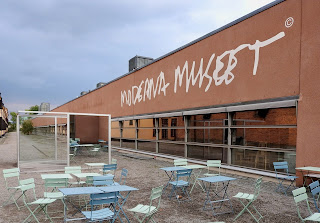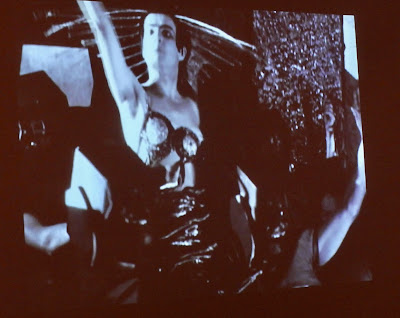ストックホルム旅行
2019年8月28日~9月4日 Stockholm Trip 28th of August ~ 4th of September, 2019 |
 |
Moderna Museet
ストックホルム近代美術館
Stockholm Museum of Modern Art
|
目次 / Contents
1) 吊るす / Hanging
2) 衣装? / Costume?
3) "アエリータ"/ "Aélita"
1) 吊るす / Hanging
吊るしてあるオブジェに興味を持ちました。
この部屋 (ギャラリー) のテーマもオブジェの説明も記録していず、わかりません。
無声映画、"アエリータ"/ "Aélita"
[1924 / 監督: ヤーコフ・プロタザノフ (1881 - 1945) ]
が上映されていたので、その映画に使用されたものなのかもしれません。
同じ部屋に衣装と思われる服も展示されていましたが、"アエリータ"のものなのか、私にはわかりません。
[1924 / 監督: ヤーコフ・プロタザノフ (1881 - 1945) ]
が上映されていたので、その映画に使用されたものなのかもしれません。
同じ部屋に衣装と思われる服も展示されていましたが、"アエリータ"のものなのか、私にはわかりません。
Hanging
I was interested in the hanging objects.
I don't know all their names because I didn't record the theme of this room (gallery) or the explanation of the objects.
The silent film, "Aélita" [1924 / Director: Yakov Protazanov (1881 - 1945)] was shown, so it may have been the ones used for that movie.
The clothes that seemed to be costumes were also displayed in the same room, but
I don't know if they belong to "Aélita".
The clothes that seemed to be costumes were also displayed in the same room, but
I don't know if they belong to "Aélita".
 |
| 飛行機なのか、鳥なのか? Is it an airplane or a bird?  心惹かれるオブジェです。 It's an attractive object.   影 / Shadow |
2) 衣装? / Costume?
8月にロンドンの テート・モダンで、
ナタリア・ゴンチャロワ / Natalia Goncharova 展 : ★ / ★
を見ました。
ナタリア・ゴンチャロワ展は、下記。
❸ A 2019年8月26日 a) ナタリア・ゴンチャロワ 展 - テート・モダン- セントラル
↓
ナタリア・ゴンチャロワ展は、下記。
❸ A 2019年8月26日 a) ナタリア・ゴンチャロワ 展 - テート・モダン- セントラル
↓
ナタリア・ゴンチャロワ / Natalia Goncharova (1881 – 1962) は、ロシア・アヴァンギャルド(前衛芸術)運動のリーダーでした。
ストックホルム近代美術館の"アエリータ"が上映されていた部屋にも衣装が展示されていました。
その衣装が、ゴンチャロワ の衣装を思わせました。
ゴンチャロワの衣装については下記。
❸ D 2019年8月26日 d) ナタリア・ゴンチャロワ 展 - テート・モダン- セントラル
"アエリータ"の衣装を担当した
アレクサンドラ・エクステル / Alexandra Ekster (1882 - 1929) も、ロシア人で、
ゴンチャロワと同時代です。
二人のセンスや影響されたものが似ていたのでしょうか?
ゴンチャロワの衣装については下記。
❸ D 2019年8月26日 d) ナタリア・ゴンチャロワ 展 - テート・モダン- セントラル
"アエリータ"の衣装を担当した
アレクサンドラ・エクステル / Alexandra Ekster (1882 - 1929) も、ロシア人で、
ゴンチャロワと同時代です。
二人のセンスや影響されたものが似ていたのでしょうか?
エクステルもゴンチャロワも立体未来主義、ロシア・アヴァンギャルドの画家と
され、両者ともパリに移住しました。
また、両者とも媒体にとらわれずに、仕事をしました。
なので、二人とも画家でありながら、衣装デザインをしているのですね。
Costume?
at Tate Modern in London.
About Natalia Goncharova Exhibition, below.
About Natalia Goncharova Exhibition, below.
Natalia Goncharova (1881 - 1962) was the leader of the Russian Avant-Garde
movement.
movement.
Goncharova was also in charge of ballet costume design, and they also exhibited costumes at the venue.
Costumes were also displayed in the room where "Aélita" was shown at the Museum of Modern Art, Stockholm.
The costumes reminded me of Goncharova.
About Goncharova's costumes, below.
❸ D 2019年8月26日 d) ナタリア・ゴンチャロワ 展 - テート・モダン- セントラル
About Goncharova's costumes, below.
❸ D 2019年8月26日 d) ナタリア・ゴンチャロワ 展 - テート・モダン- セントラル
Aélita's costume designer Aleksandra Ekster (1882-1929) was a Russian and was the same age as Goncharova.
Were their senses and influences similar?
Both Ekster and Goncharova were Cubo-Futurism and Russian avant-garde painters, both of whom emigrated to Paris.
Moreover they worked without being bound by the medium.
So, both of them were painters, but they also designed costumes.
Were their senses and influences similar?
Both Ekster and Goncharova were Cubo-Futurism and Russian avant-garde painters, both of whom emigrated to Paris.
Moreover they worked without being bound by the medium.
So, both of them were painters, but they also designed costumes.
3) "アエリータ"/ "Aélita"
(ここでほんの少しアエリータが見られます→★)
アレクセイ・ニコラエヴィッチ・トルストイ (1883 - 1945)のSF小説『火星にいった地球』[原書: Aelita : 1923 / 日本語版: 訳; 西原久史郎 / 絵 ; 日下香之助 / 講談社 1957] の映画化です。
ちなみに、『戦争と平和』(原書初版: 1869)や
『アンナ・カレーニナ』(原書初版: 1878) を書いたのは、
レフ・ニコラエヴィチ・トルストイ(1828 - 1910)です。
ちなみに、『戦争と平和』(原書初版: 1869)や
『アンナ・カレーニナ』(原書初版: 1878) を書いたのは、
レフ・ニコラエヴィチ・トルストイ(1828 - 1910)です。
私は、モノクロ、ソビエト連邦の無声映画というと、
"戦艦ポチョムキン" / Battleship Potemkin
[1925 / 監督:セルゲイ・エイゼンシュテイン (1898 - 1948) ]
を思い出します。
"戦艦ポチョムキン" / Battleship Potemkin
[1925 / 監督:セルゲイ・エイゼンシュテイン (1898 - 1948) ]
を思い出します。
違う言い方をすれば、この手の映画で、私がタイトルを思い出せるのが、
"戦艦ポチョムキン" しかありません(笑)。
"戦艦ポチョムキン" しかありません(笑)。
私は、美術館での展示上映や、TVの放映、Youtubeでの動画などで、垣間見る程度ならいくつこの種類の映画をいくつか見ましたが、最初から最後まで、観賞したのは、"戦艦ポチョムキン" のみなのです。 (ここで戦艦ポチョムキンが見られます→★)
"Aélita"
"Aélita" is a black and white, Soviet Union (1922 - 1991) silent film.
(You can see a little "Aélita" here→★)
This is a film adaptation of the science fiction novel "Aelita" (Original 1923 / English edition 1950) by Aleksey Nikolayevich Tolstoy (1883 - 1945).
By the way, "War and Peace" (original first edition: 1869) and "Anna Karenina" (original first edition: 1878) were written by Leo Nikolaevich Tolstoy (1828 - 1910).
By the way, "War and Peace" (original first edition: 1869) and "Anna Karenina" (original first edition: 1878) were written by Leo Nikolaevich Tolstoy (1828 - 1910).
The black and white, Soviet silent film reminds me of
Battleship Potemkin [1925 / Director : Sergey Eisenstein (1898-1948)].
Battleship Potemkin [1925 / Director : Sergey Eisenstein (1898-1948)].
In other words, for me, the only title that appears in this kind of movie is "Battleship Potemkin" (Laugh).
I have seen a few excerpts in museum screenings, TV shows, YouTube videos, etc., but I only watched "Battleship Potemkin" from the beginning to the end.
(You can see "Battleship Potemkin" here→★)
 |
"アエリータ"の一場面 / A scene from Aélita" ; ★
|
"ヤコフ・プロタザノフ監督の映画アエリタは、ロシア・アヴァンギャルドでマルチメディア傾向の一例と見なすことができます。
アエリタは初期のSF映画の1つであり、伝説の映画 『メトロポリス』(1927年)の制作においてフリッツ・ラング (1890 - 1976) に影響を与えたとされています。
アエリタでは、ロシア人が社会主義革命を広めるために、労働者が搾取されて閉じ込められる火星、赤い惑星に上陸します。
衣装デザインは、演劇と芸術のための彼女の構成主義実験の自然な拡張として、アレクサンドラ・エクステルによって作成されました。
火星人のためのエクスターの衣装は、キャラクターに形と生命を与えることができるトータル・コスチュームを作成したために、俳優の演技が制約されました。"
当時のほとんどのロシアのアーティストがどちらにも傾向しているような印象があります。
 |
"アエリータ"の一場面 / A scene from Aélita"
|
According to their explanation by the Museum's website,
"The film Aelita, directed by Yakov Protazanov, can be seen as an example of the transdisciplinary and multimedial inclination of the Russian avant-garde.
Aelita is one of the earliest science fiction movies and has been cited as an influence for Fritz Lang (1890 - 1976) in the making of his legendary film Metropolis (1927).
In Aelita the Russians land on Mars, the Red Planet where workers are exploited and confined, to spread the socialist revolution.
The costume design was created by Aleksandra Ekster as a natural extension of her Constructivist experiments for theatre and art.
Ekster’s dresses for the Martians define the actions of the actors in order to create a total costume capable of giving shape and life to the characters."
The Russian art movements of this era include Russian Constructivism and Cubo-Futurism, but I don't really understand the difference.
The impression is that most Russian artists at the time tended to both.
The impression is that most Russian artists at the time tended to both.
 |
"アエリータ"の一場面 / A scene from Aélita"
|
映画観賞は、数分しかできませんでした。
その時間だけでの印象は、ドタバタとしたオペラのイメージがしました。
この映画の重要な点は、物語というよりは、SFを扱ったことなのではないかと思います。
次のセクションは、同じ建物内に設置されている、建築博物館 : ArkDes についてです。
I could only watch the film for a few minutes.
The impression, just in that time was the image of a slapstick opera.
I think the important point of this movie is that it deals with science fiction rather than a story.
I could only watch the film for a few minutes.
The impression, just in that time was the image of a slapstick opera.
I think the important point of this movie is that it deals with science fiction rather than a story.
The next section is about the Architectural Museum : ArkDes in the same building.





0 件のコメント:
コメントを投稿